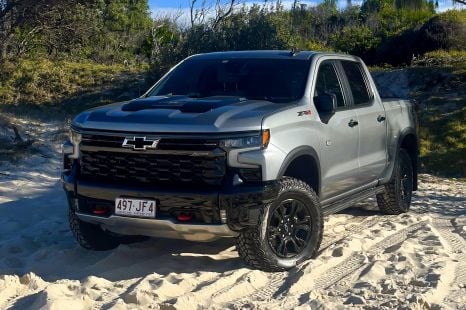

William Stopford
2025 Chevrolet Silverado ZR2 review
1 Month Ago
The much-anticipated update to Australia’s most-popular vehicle hits the marks where it counts – but is it enough?
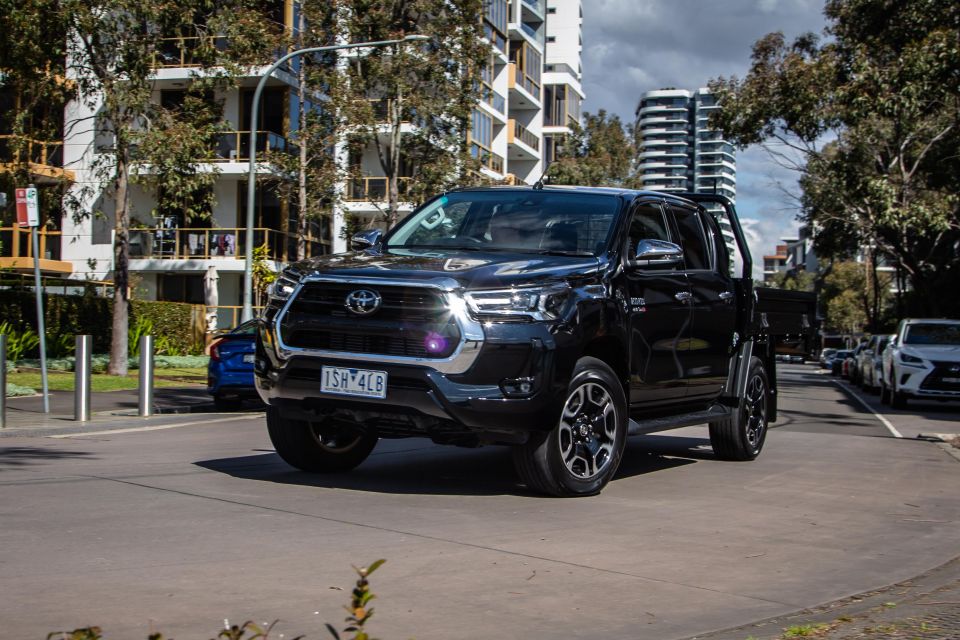
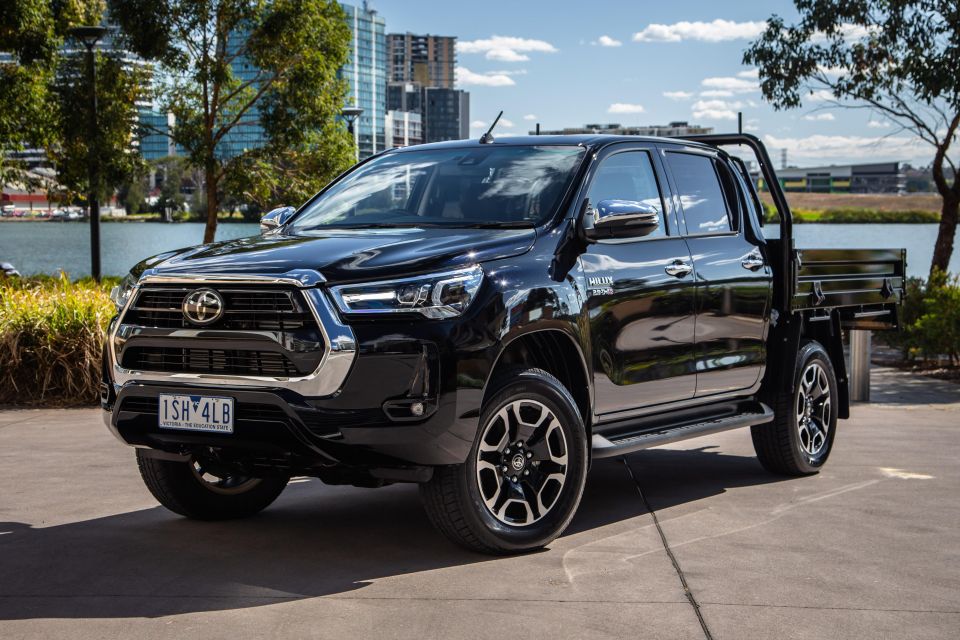

Journalist
New from
$22,325
excl. on-roads

Journalist
New from
$22,325
excl. on-roads


Journalist
New from
$22,325
excl. on-roads

Journalist
New from
$22,325
excl. on-roads
Quickly see how this car stacks up against its competition. Select any benchmark to see more details.
Where expert car reviews meet expert car buying – CarExpert gives you trusted advice, personalised service and real savings on your next new car.
It’s two days out from the face-lifted 2021 Toyota HiLux on-sale date and its official webpage landing page has frozen. Temporarily, mind, and unsurprisingly. It seems I’m one of the many researching the updates to Australia’s biggest-selling model range.
Thankfully, unlike many fellow web-benders, I’ve just gotten my eager mitts on the new SR5 4×4 Double Cab, fresh off the boat and the first genuine indicator whether a revised 2021 Toyota HiLux warrants the collective anticipation and excitement.
Here’s the update cheat sheet. There’s more engine output and towing capacity to closely align mid- and high-grade diesel 4×4 versions of HiLux with the best of the Ford Ranger, the arch-rival that’s gone toe-to-toe with the HiLux for best-selling vehicle in Oz for the past three years.
The Toyota HiLux’s suspension, specifically the unladen ride quality, has been revised to make it nicer to live with while the 4×4 versions’ steering system has been retuned for easier use around town.


In most variants, it sports a larger, bolder grille inspired by Toyota’s American pickup range with redesigned headlights and taillights, the HiLux adopting a more aggressive ‘family’ look as has been the trend with the recently redesigned RAV4 and Corolla lines.
It also brings Apple CarPlay and Android Auto mirroring (plus knobs for volume and tuning) that moves Toyota’s infotainment system a big step closer to the mainstream for accessibility and usability.
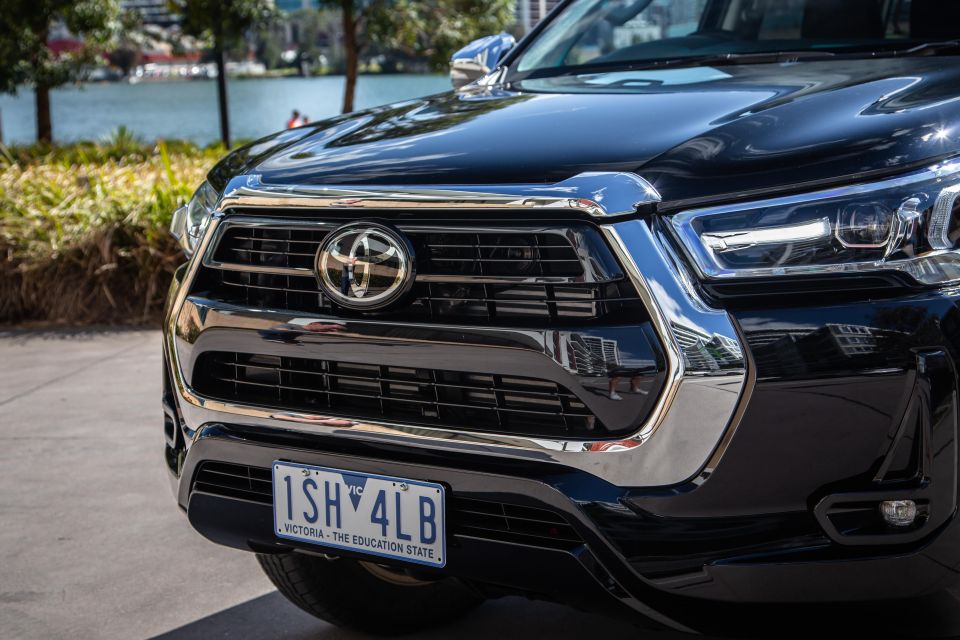


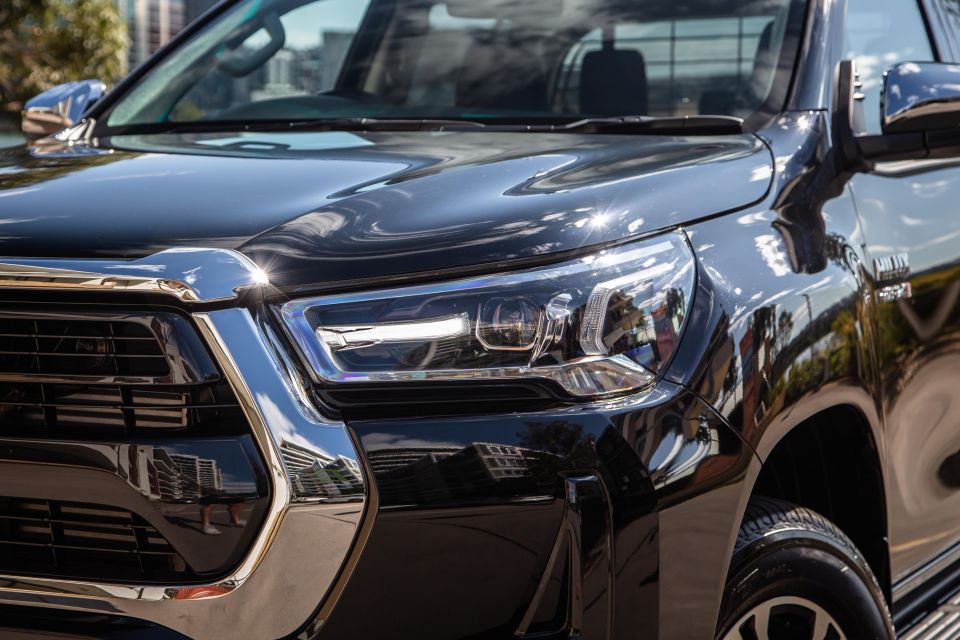
Fortuitously, we’ve gotten a hold of one of the two new variants in the 33-version strong launch stable: the SR5 Double Cab cab chassis. Together with the top-spec SR5+, you can now buy a two-row tray-back HiLux with all of the high-spec ‘lifestyle’ trimmings.
While it could be argued there’s not a huge amount of change to HiLux’s nicer crop – and even less in the tradie end of the range – is there enough improvement in the right areas? And enough of it to justify new HiLux’s price hike?
Pricing is…complicated.
On list pricing, HiLux is up a bit across the board. In the case of the SR5 dual-cab 4×4 auto pickup for example (not our cab chassis) the outgoing $57,240 list price is up $2700 to $59,920 in newly face-lifted form. However, the dual-cab auto version being put to pasture had, for quite some time and well before run-out, been a sub-$55k driveaway prospect. You’ll need closer to $63k to get the face-lifted pickup on road outside of offers…
However, our tray-back newbie, available in automatic only, comes in at $58,420before on-road costs, or $1500 less than the ute version. Previously, if you really wanted an SR5 4×4 Double Cab auto in cab chassis form, you had to get the ute version and convert it. Farmers with a taste for nicer stuff can, to a degree, rejoice.
The caveat to all of this is that with the updated Ranger and brand new Isuzu D-Max both lobbing now, the complexion of the driveaway pricing and offers is a moving target. We’ve covered this more comprehensively in our three-way comparison of these nameplates.
So how does our new boy’s $58,240 list sit? The SR5+ cab chassis auto version, with its extra window dressing and leather trim, wants a further $2500. Dropping down the range, the more mundane SR trim with identical powertrain is $50,660 list for the auto and $48,510 list as the only 4×4 double-cab cab chassis offered in manual form.
Our black mica tester has one of the five different premium paint options, priced at $600.
There’s no doubting the SR5’s popularity as, traditionally, the high-spec variant has been one sizeable step up from the tradie-oriented, steel-wheeled SR sat below it.
Alloy 18-inch wheels with 265mm tyres, lashings of chrome, and LED auto-leveling headlights, daytime running lights and fog lights signify you’re in upmarket ute territory. Side steps and electric folding (if manually controlled) mirrors are standard SR5 fitment, though the cab chassis misses out on the reversing camera and six-sonar proximity sensors that are fitted to the pickup versions. The spare is full-sized with a matching alloy rim.
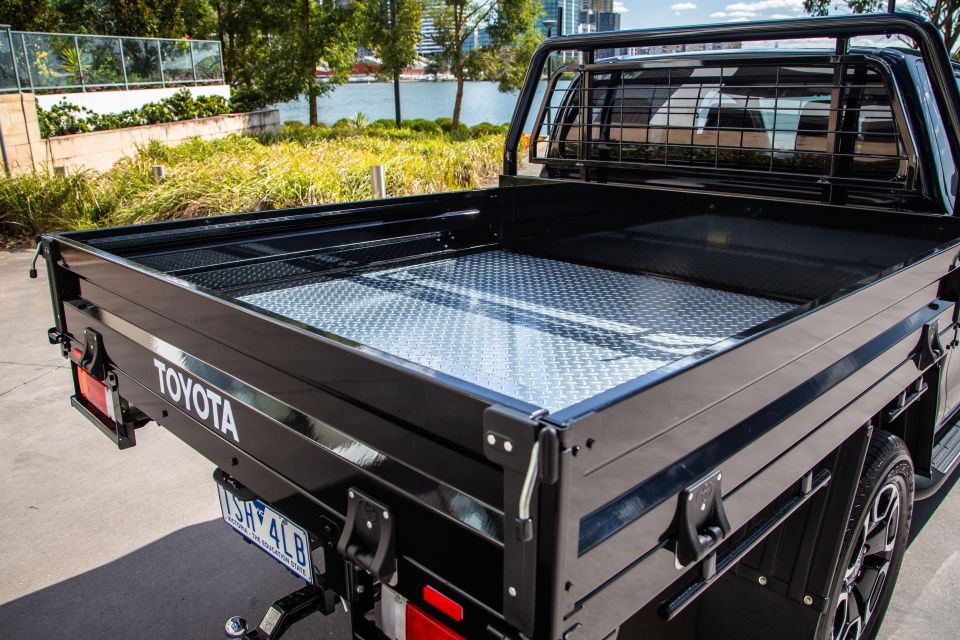
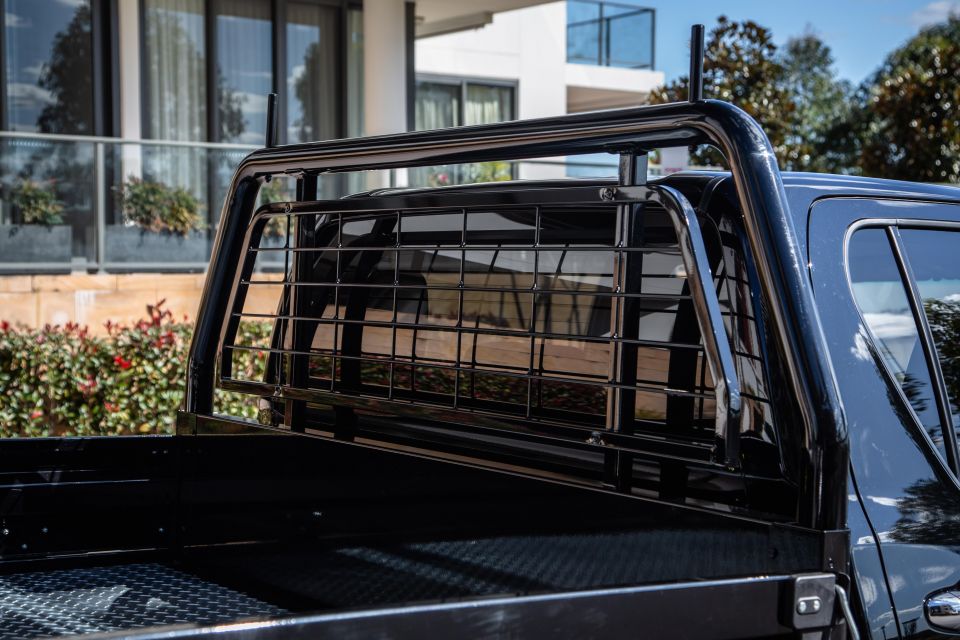

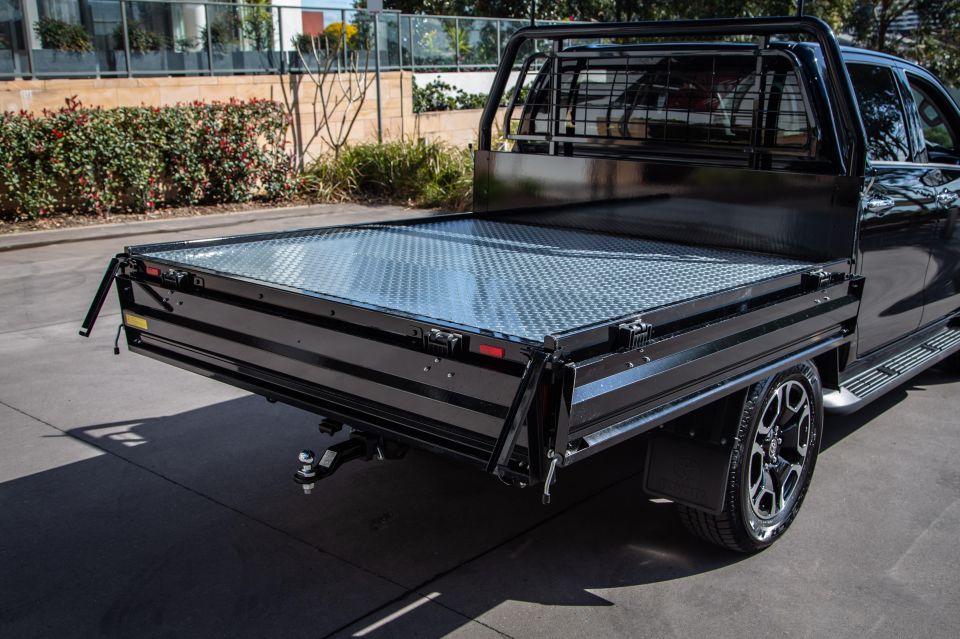
Tray format apart, there’s not much new outside. Inside, though, the conspicuous change is the upgrade from a 7.0-inch touchscreen infotainment format to a larger 8.0-inch unit with dedicated short-cut buttons and tuning and volume dials. Plug-and-play Apple CarPlay and Android Auto are now included in conjunction with the proprietary like-it-or-loathe-it Toyota app format and, like its predecessor, the new SR5 bundles in DAB+ and in-built sat-nav.
Handy, too, is the inclusion of dual 12-volt/120w (in the central stack) and a 220-volt/100w three-pin outlet (in the console bin) to compliment the single USB port up front.
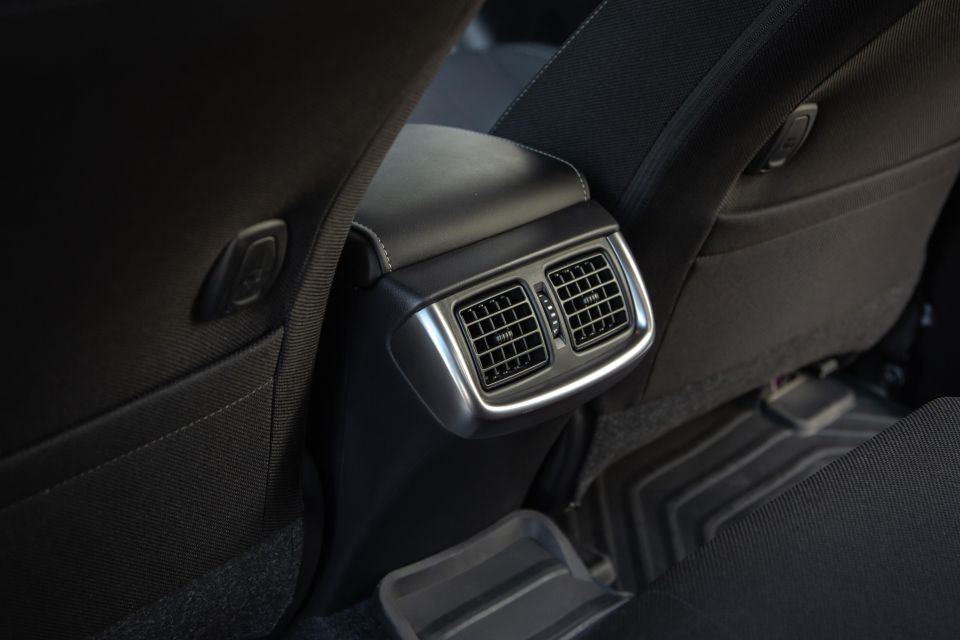
Spec level is a little mixed. The SR5 fits nice stuff such as push-button start, a multi-function wheel, adaptive cruise control, an electronic Auto LSD, hill descent control, a 4.2-inch driver’s screen with digital speedo and one-touch functionality for all electric windows.
There’s also rudimentary stuff like cloth trim, mechanical driver’s seat adjustment, fake leather wheel trim, single-zone climate control and manual wipers.
Smartphone mirroring apart, there’s not much significant change on the SR5’s features list.
As a face-lift, the MY20 carries over this eighth generation’s five-star ANCAP rating, coming into effect in mid-2019 with the inclusion of autonomous emergency braking across the entire HiLux range. The AEB fitted is an all-speed design (up to 180km/h) with pedestrian and daytime cyclist detection up to 80km/h.
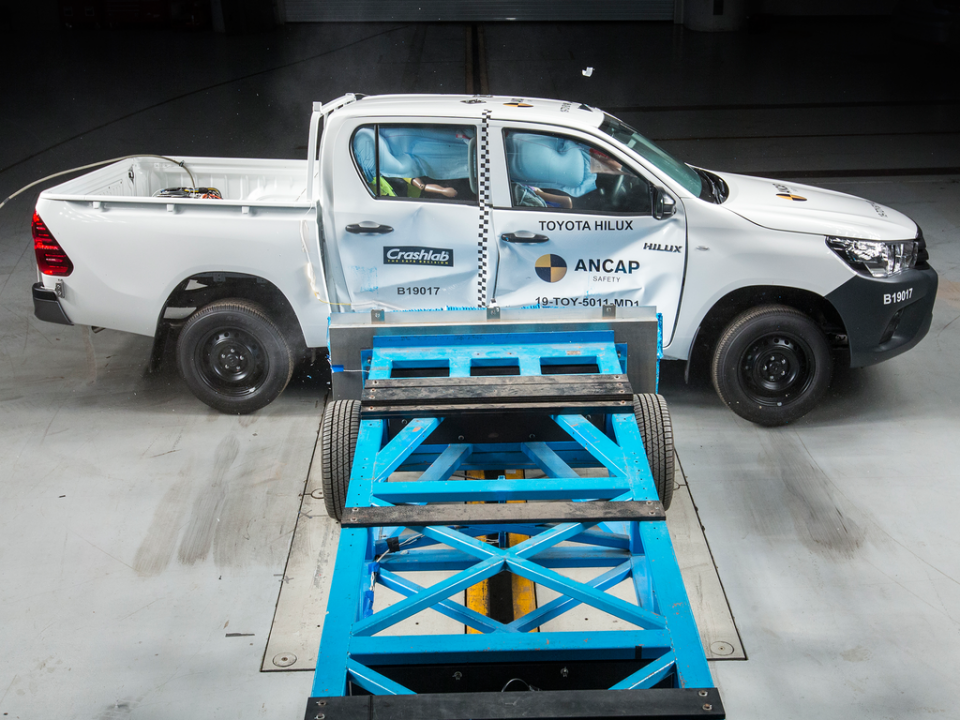
The SR5 also fits seven airbags – front, side, curtain and driver’s knee – as well as lane-departure warning and lane-keeping assist, hill descent control and speed limit advice. The Auto LSD feature is essentially an electronic engine and braking control that aids when off-roading and a wheel loses traction. The HiLux also fits two top-tether and two ISOFIX mounting points in row two.
While the cab chassis versions are included in the five-star ANCAP assessment, these models don’t feature the reversing camera or front and rear parking sensors of the pickup models.
The facelift gets a mildly massaged version of the outgoing cabin mixing the familiar fancy and stylised dash fascia with a dark, monochromatic theme broken up only by the odd splash of frosted silver and speckled not-quite-piano black.
The old blue-tinged display lighting has been tamed a bit and the instruments replaced by ornate ‘machinery-themed’ analogue gauges and needles flanking a 4.2-inch colour driver’s screen as a sort of visual centerpiece. Design wise, it kind of works. Thankfully – hooray – Toyota HiLux now fits a digital speedo.


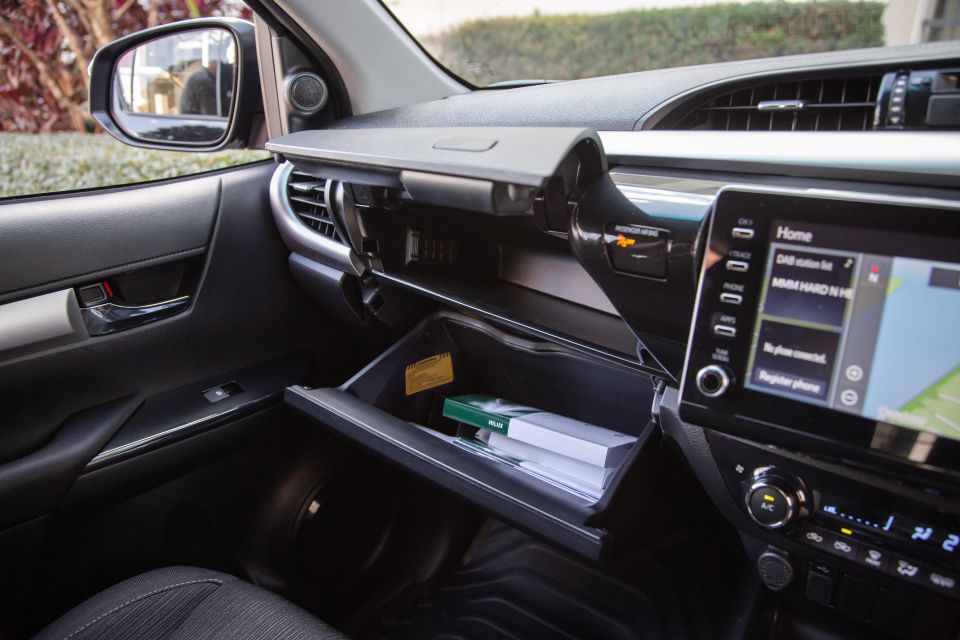

The thick-framed infotainment screen has clearly grown in presence and the physical shortcut buttons and dials are a godsend. The actual content is no grand leap in sharpness or slickness though the inclusion of Apple CarPlay and Android Auto is much appreciated and connects with an ease some German car companies should take heed of.
There are still acres of hard, shiny plastic, including pretty much the entire door trims and in all of the storage compartments, where everything from cups to keys will rattle noisily. Areas such as the console bin lid and seat height-adjust lever also feel cheap and flimsy.
Despite the texture and colour variation in obvious places, it leans a little too far into tradie spec for an up-spec model. The woven seat fabric is fairly decent and undoubtedly hard-wearing, but things such as the obviously synthetic steering wheel rim shouldn’t have a place in any vehicle north of $60k on road.

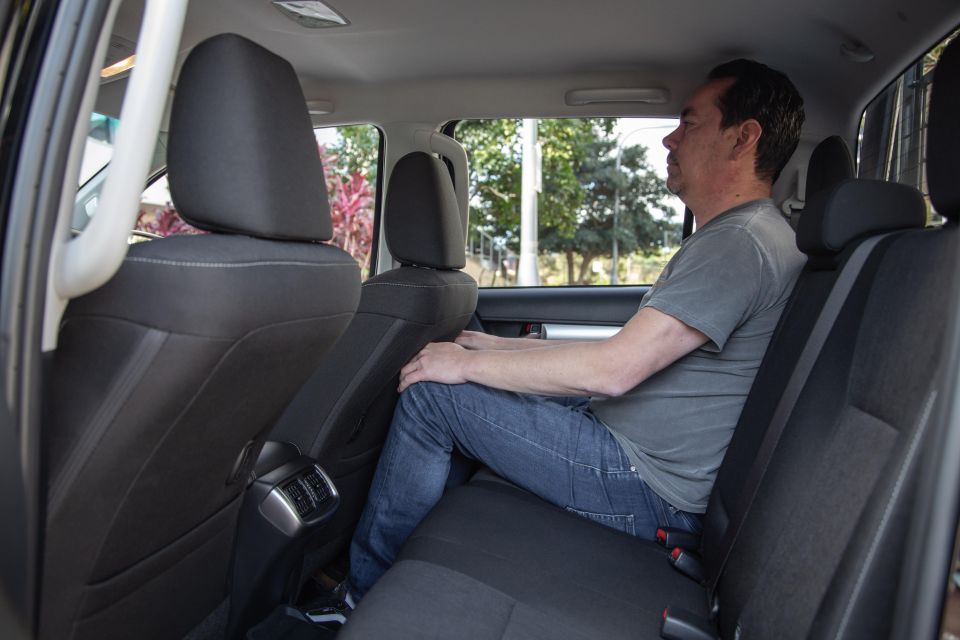


That said, the seats themselves are supportive and SR5 is actually quite a welcoming and comfy place to spend time in. The single USB port is a head-scratcher, presumably catering to one occupant’s smartphone mirroring whims while leaving everyone else without recharging power unless they’re brought a 12V or three-pin charging facility. At least there are plenty of places to store bottles (each door bin), while you can keep a sandwich cool in the chilled upper glove box bin.
Row two is a bit mixed for adult accommodation. Head and shoulder room is decent enough for two adults though knee and toe room is quite restrictive. Three blokes across will be a squeeze. Nice large grab handles on the door pillars (in both rows) are smart inclusions and the rear air vents and one-touch windows are most welcome.
The overhead grab handles, though, come very close to taller occupant heads, which pose a bit of a concern during the tossing about typical of proper off-roading.
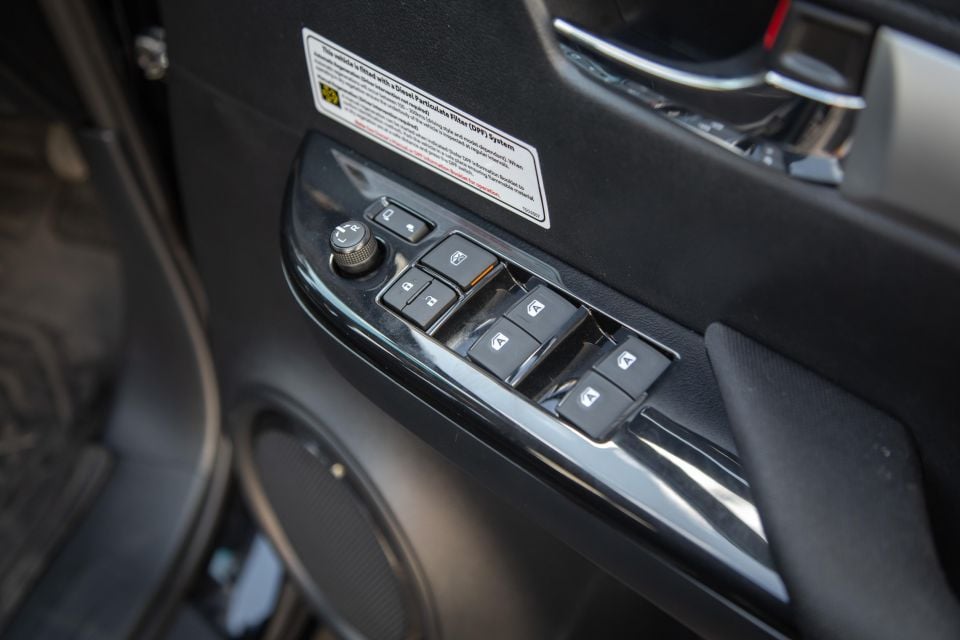


The Toyota-branded tray is a whopping 1800mm long, 1770mm wide and 270mm high – a fair bit larger flat space on its diamond plate floor than the pickup’s modest 1109mm width between the inner arches.
The tray is solidly made, rattle-free, has smooth action releasing or engaging its interlocking sidewalls and looks smart in colour-matched paintwork. That said, the speckled black mica finish will be a bugger to touch up once it starts to get scratched up.
Of course, the headline update is the increased outputs from the otherwise familiar 2.8-litre turbo-diesel four, now 150kW and 500Nm – sizeable 20kW and 50Nm boosts – and much closer to that of key rival Ranger’s 2.0-litre turbo-diesel, which now has a scant seven-kilowatt advantage. Manual models make do with a lower 420Nm tune, however.

Changes? A new engine block, gaskets, exhaust manifold, larger ball-bearing turbocharger and higher-pressure common-rail injection system not only lift outputs but also spread peak torque across the wider (1600-2800rpm) band and return more favourable economy.
Whereas the old SR5 dual-cab pickup claimed 8.4L/100kms on the ADR combined cycle, the newer version (of the pickup rather than cab chassis) has a markedly fitter 7.9L claim. That said, our time with the SR5 returned bang on 10L/100kms, which is exactly what we returned when we recently tested the old SR5 (pickup) version said to be a half-litre thirstier…
There’s nothing broken or requiring fixing further downstream, with the six-speed automatic backed by on-demand all-wheel drive with familiar 2H-4H-4L switching and a rear differential lock standard.
Outside of the engine, the one other area of substantial upgrading effort is the suspension – specifically, the HiLux’s ride comfort. Toyota says Aussie engineers spent “years” developing the initial “rugged” suspension tune in the lead up to the eighth-generation HiLux’s 2015 debut and the company’s local team had a fair hand this time around making it nicer to live with day to day.


How so? Through longer rear leaf springs, wider spring spacing, retuning of spring, damper and bushing rates all round as well as revising the cabin mounts.
So, have the key MY20 changes to engine and chassis made a noticeable difference to HiLux’s on-road behaviour? Indeed they have.
The HiLux, at least in 4×4 auto guise on SR5 rolling stock, is now a more settled, compliant and polished ute to drive. Is it a quantum leap? No. Is it a marked enough evolution to detect without direct comparison with its forebear? Most certainly…even if it’s tough to quantify exactly by how much.
I long considered the outgoing HiLux a bit boisterous under the bonnet, as if it was working a little too hard for its keep, though such thoughts were constantly drowned out by a ride so terse it’d turn your innards like a milkshake. Or so seemed the case experiencing HiLux in the company of Ranger (a breed not without its own faults).


With the MY20 Toyota HiLux, critically at least, I sense it’s all to play for.
Out of the gates, the revised 2.8-litre feels healthier, with a stronger undertow of torque, a slightly crisper response and less effort in making haste. There’s an Eco drive mode to dull its reaction to favour consumption and a Power mode to make the turbo-diesel more alert but, frankly, the default setting is impressively flexible and offers a satisfying middle ground that’s both gusty and under-stressed.
It’s paired with the six-speed auto very nicely: clean up-shifts, smooth all-round behavior and no noticeable histrionics. Progress now seems more polished and dignified, a bit less agricultural and a tad more upmarket.
The same can be said about the ride, retuning promising dividends unladen in what was mostly around town assessment.
The HiLux’s ride now seems more settled. The old version was downright jagged at low speeds and, while a bit of vertical movement is part and parcel of the 4×4 ute DNA, this revised tune rounds out the hard-edged hits and smothers smaller road imperfections enough to alleviate punishment and fatigue. It also seems to suppress vibration better, resulting in not just smoother passage but a quieter one at that.



Smoother riding, quieter, less stressed: no great leaps in any department but improvements where they’re warranted, working together to create a nicer, comfier and more dignified experience. Well done.
Less obvious is the steering fettling. A new variable-flow hydraulic steering pump specifically aims to provide higher power assistance at parking speeds and if it does so, it’s only by shades. It mightn’t be quite as lumbering as before but it remains much heftier than your average passenger car or SUV, though it does lighten up nicely on the move.
If there’s one glaring shortcoming with MY20 HiLux, it specifically applies to the SR5 Double Cab cab chassis’ lack of reversing camera or sensors. There’s a massive rear overhang, my 178cm frame can barely see the tray’s trailing edge through the rear window, and the HiLux is such a large unit you must reverse park the thing in narrower parallel spaces. Needless to say: hitching a trailer is either a two-person job or an experience in highly frustrated guesswork…

Where expert car reviews meet expert car buying – CarExpert gives you trusted advice, personalised service and real savings on your next new car.
Speaking of which, HiLux’s larger heartbeat brings with it proper, class-competitive – and, of course, Ranger matching – 3500kg braked towing, aided by the fitment of large 319mm opposed-caliper front anchors and 295mm rear drums. Unbraked towing remains a decent 750kg.
In terms of payload, the SR5 cab chassis is rated to 1105kg, which is pretty decent if down a bit on some other 4×4 variants in range. GVM is 3050kg.
The HiLux comes with a five-year warranty with unlimited-kilometre coverage for private use and 160,000km coverage for commercial use. Toyota will also extend the engine and driveline warranty a further two years on a conditional basis.



Servicing is the stinger. Intervals are a scant six months (if 10,000km) at $250 per service and the cap guarantee runs out for just four visits/two years. That’s slim, pricey and inconvenient compared with the 12-month intervals and generally lower costs of some key rivals.
A cab chassis version of the SR5 Double Cab rounds out the HiLux range nicely and the way it performs gives a strong sign that Toyota has moved the game along where it matters for its pickup versions, too.
Upping engine outputs and towing capacity gives buyers what they want. The chassis changes improve the quality of the experience. The infotainment updates keeps HiLux up with the Joneses. Styling tweaks are, well, simply inevitable.
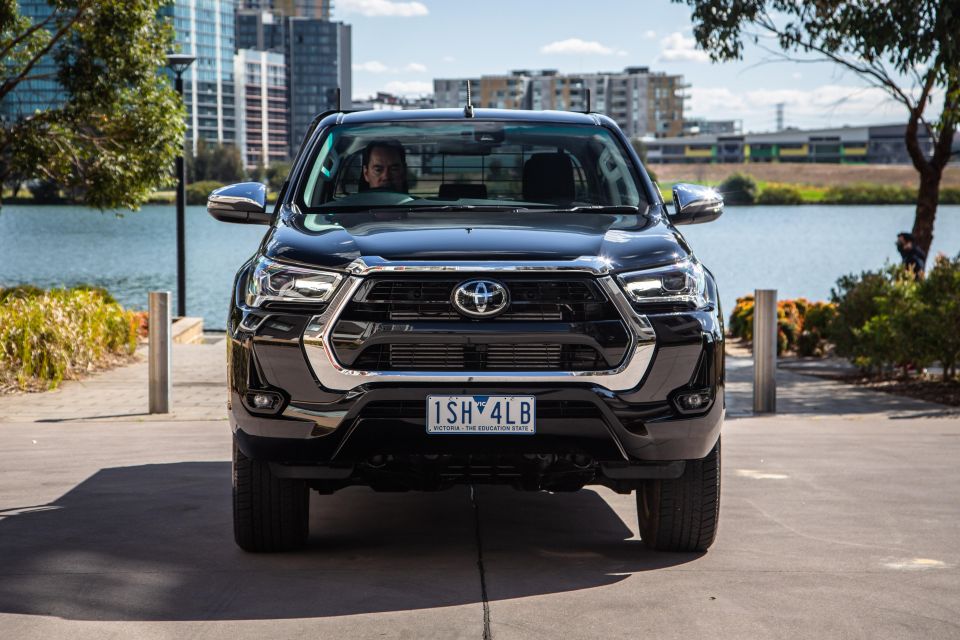
Could Toyota have addressed some of the tradie-isms like the cheap plastics and basic equipment and feature choices at this price point? Sure. Would the added investment have moved even more HiLuxes from showrooms? Probably not.
Regardless, the facelift HiLux is more match-fit for what is, popularity-wise, motoring’s major league. There’s just enough extra goodness in the right places.
Whether the high-end diesel 4x4s represent a better buy than those in the outgoing range will really depend on what happens with offer-driven driveaway pricing from hereon in.
Where expert car reviews meet expert car buying – CarExpert gives you trusted advice, personalised service and real savings on your next new car.


William Stopford
1 Month Ago


Paul Maric
22 Days Ago


Max Davies
16 Days Ago
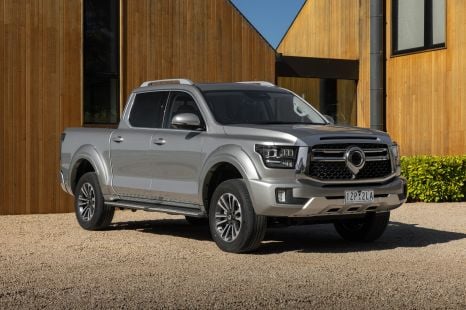

Marton Pettendy
9 Days Ago


Josh Nevett
8 Days Ago
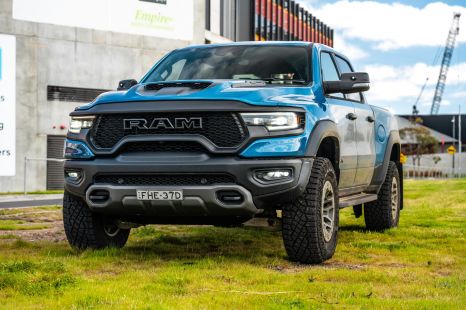

Max Davies
7 Days Ago